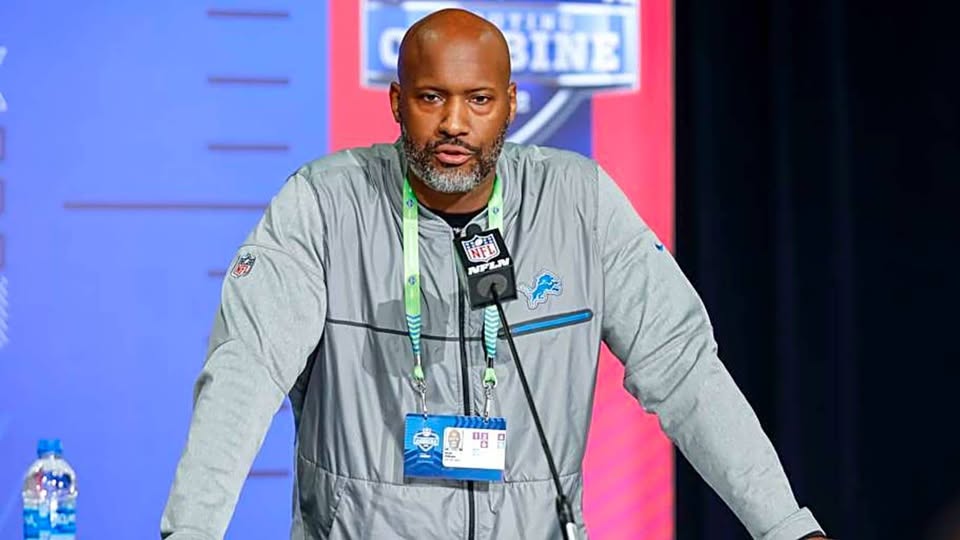In the long shadow cast by Brad Holmes’s aggressive roster building, the Detroit Lions enter what could be a defining offseason as they eye the 2026 NFL Draft. Holmes, the Lions’ general manager since 2021, has cultivated an identity built on athleticism, character, and culture fit—regardless of traditional draft boards . Now, entering 2026, Detroit again appears ready to strike boldly, this time targeting one of college football’s most dynamic linebackers in Round 1, and doubling down with another defensive build in Round 2. Here’s an in‑depth look at Detroit’s possible two‑round slate, and how it aligns with Holmes concept of “violent” defense married to positional versatility.
With the Lions holding the No. 29 pick in Round 1 (based on an expected finish in 2025), attention is riveted on a linebacker from a Power Five school—someone like South Carolina’s Demetrius Knight Jr., a prototype of elite athleticism and smart play Knight stands at around 6‑2, 235 pounds, yet owns rare explosiveness: a RAS around 8.2, assertive tackling and play intelligence, and coverage ability that belies his size. These traits fit seamlessly with Holmes’s profile for linebackers: explosiveness, speed, plus consistency in the box
Knight’s appeal deepens when seen through Detroit’s lens. Holmes has long valued linebackers who excel in run‑support and special teams, with strong field instincts over flashy pass‑coverage flair . Knight, a captain in college (showcasing leadership), combines that physicality with intelligence—he diagnoses quickly, finishes tackles, and moves laterally—factors that are critical in Holmes’s scheme.
Yet Detroit isn’t often a team that drafts linebackers this high. Jack Campbell, a first‑round linebacker in 2023, quickly earned a spot on the PFWA All‑Rookie team Combining with Derrick Barnes, Christian Holmes, and now a rookie class deepened in 2025, the Lions boast substantial depth at the position. However, with projected retirements and free agency departures looming, the appetite for more youth in the core of the defense remains. And if Knight is there at 29, the Lions won’t balk; they’ll lean in.
In Round 2, selecting at around No. 60–65, Detroit circles a secondary or EDGE player who complements the front seven. A top scenario involves a long, versatile cornerback with high football IQ—someone like Alabama’s Domani Jackson—who checks boxes for special‑team value, slot coverage, and upside as a primary defender . Jackson offers skill that would allow Detroit flexibility: deploying him in nickel or base defense while keeping the front seven intact. His jumper ability and instincts make him a possible starter early, fitting Holmes’s penchant for multi‑role defenders
Another Round 2 angle sees Detroit drafting a powerful edge rusher—someone like Cashius Howell from Texas A&M—who blends inside–outside flexibility with elite effort and pursuit traits Howell’s 4.65 forty places him in the 93rd percentile for edge prospects, and his relentless chase complements the established group led by Aidan Hutchinson. Holmes respects motor, effort, and football character—traits Howell brings abundantly
Holmes’s history shows willingness to let positional boards bend around fit. He has been known to draft players Wright or “reach” early if they exhibit high character, athleticism, and developmental trajectory—Amon‑Ra St. Brown and Brian Branch being shining examples The Lions are not only buying traits; they’re buying mindset. They value leaders—senior captains with film, pass‑rush savvy or box intelligence, and versatility to play multiple roles on defense .
Scout fan conversation supports this. The Lions consistently select linebacker targets who demonstrate tackling violence, strong run defense, and a refined burst—cornerstones of their drafting ethos . Physical, high‑motor playmakers, with special‑team immediacy, dominate Holmes’s priorities, instead of stat‑padders or projected specialists.
Knight, Howell, Jackson—they all align with balls‑to‑the‑wall Detroit.
Pulling it together, here’s a summary of a 2026 two‑round mock:
Round 1 (Pick 29): LB Demetrius Knight Jr. (South Carolina)
A 6‑2, 235‑lb inside linebacker with elite explosiveness (RAS ~8.2) and strong instincts. Michigan fits: he reads blocks, diagnoses quickly, takes on downhill rush lanes, and flashes special‑teams prowess.
Brad Holmes values meeting size and character thresholds—Knight checks both. Leadership (team captain), run‑support strength, and coverage upside create a three‑down question: yes or no? Detroit makes the call.
Round 2 (Pick ~60): CB Domani Jackson (Alabama) or EDGE Cashius Howell (Texas A&M)
Jackson would bring length, ball instincts, and slot flexibility—qualities Detroit prizes in its secondary. Howell offers pass‑rush upside, athletic traits, and relentless pursuit, fitting Detroit’s defensive swagger.
Either choice complements Knight by rounding out the defense: pairing physicality with coverage or pass‑rush versatility.
Weaving back through Holmes’s past draft pattern strengthens confidence in this projection. He’s not stick‑lered to “positional value.” Rather, he picks name or board flexibility in service of traits—high effort, high IQ, high athletic upside. Under Brad, Detroit has shown they’ll cross positional lines to draft what they believe is the right person at the right time
Likewise, Detroit doesn’t draft for need. Instead, they align on philosophy—adding versatility, football mindsets, and athletic ceiling. Holmes’s track record includes supplemental first‑rounders who offset perceived boards—but not needs: Samson Ebukam, Brian Branch, Jack Campbell. The latter is already anchoring the defense. Detroit’s interest lies in building a relentless pack able to fly around and hold the line when opponents run, with the speed to chase down sideline plays.
Now entering 2026, the pieces are in place: Hutchinson is locking edges; McNeill is clogging the trenches; Campbell is running the show in the box. The next domino drop should be a player with length across the second level—Knight—paired with a finesse or edge complement from Round 2. Detroit’s defense would reframe as a bonded core—roots in run stuffing, wounds in coverage, teeth in pursuit.
A year out, initial mock projections already place Knight in this window: Pride of Detroit’s list of potential second‑round linebackers includes Knight, placing him firmly in Holmes’s mind . Another mock picks Knight as a second‑round candidate because he “brings the type of makeup that’s hard to ignore if the Lions want a destructive ‘backer on early downs with special teams upside and leadership traits” (. That exactly mirrors Holmes’s style.
Looking ahead into camp, Knight’s combine performance will matter. Lions favor top percentile 10‑yard splits—nearly all their draft picks since 2022 have belonged in the 70th percentile or higher for explosivenes Knight, Howell, Jackson—they hit that blend of size, speed, effort, and mindset.
Detractors say the Lions already have depth at linebacker and secondary pre‑2026. That’s fair—but every team healthy through free agency still sees turnover. Barnes, Nowaske, Pitt, Turner, Niemann—have upcoming free agency or injury history Cornerback depth, too, sees turnover every year; Jackson or Howell bring youth and athleticism to replace departures or preseason casualties.
Holmes has shown he prefers ceiling and mindset to safe picks. JB Campbell and Amon‑Ra St. Brown were selected with belief they’d grow—and they did . Expect the same logic for Knight—high floor, higher ceiling, plus the attitude to spark Detroit’s swagger.
Backing this strategy, one or two scouting reports stand out.
At South Carolina, Knight plays with a violent edge and fluidity. Ball reports note his ability to “run through blocks, come downhill fast, tackle forward, and stay disciplined in coverage.” A team captain, he runs the defense with voice and intellect. Athletic testing places him above 85th percentile in short shuttle and 20‑yard splits, giving him sidelines‑to‑sideline range.
Meanwhile, Howell’s tape shows a persistent edge rusher who never quits. Despite being second fiddle to bigger names at Texas A&M, he managed 9.5 sacks at Bowling Green and transferred up to SEC, where he faced Penei Sewell—gaining real exposure. Howell recorded 4 sacks even as a backup, showing both burst and effort
Jackson at Alabama brings ball instincts with length (6‑1+, 190-ish) and demonstrated shutdown ability in press and slot roles. He broke up seven passes in a season, with two interceptions, showing instincts .
In summary, Holmes’s two‑round 2026 mock draft for Detroit reads like this:
Round 1, Pick 29: South Carolina LB Demetrius Knight Jr. — Elite athlete, playmaker, leader, perfect Holmes blueprint.
Round 2, Pick ~60–65: CB Domani Jackson or EDGE Cashius Howell — Versatility, athletic upside, alignment with Detroit’s gritty addition mold.
This plan adds athleticism, culture, and blueprint consistency. It builds on Holmes’s aggressive draft philosophy—leaning into traits, fit, and football intelligence over positional bingo.
If this comes to pass, Detroit’s defense post‑2026 draft will feature Hutchinson, McNeill, Knight, Campbell, Howell, plus a secondary flush with Jackson-like length and IQ. It sets a tone: size, speed, effort, intelligence—mixed with leadership. And all drafted carefully by Brad Holmes, who continues to bet on himself and his approach. Historically it’s paid off; Detroit’s 2026 defense might well cement his method as modern drafting gold.



